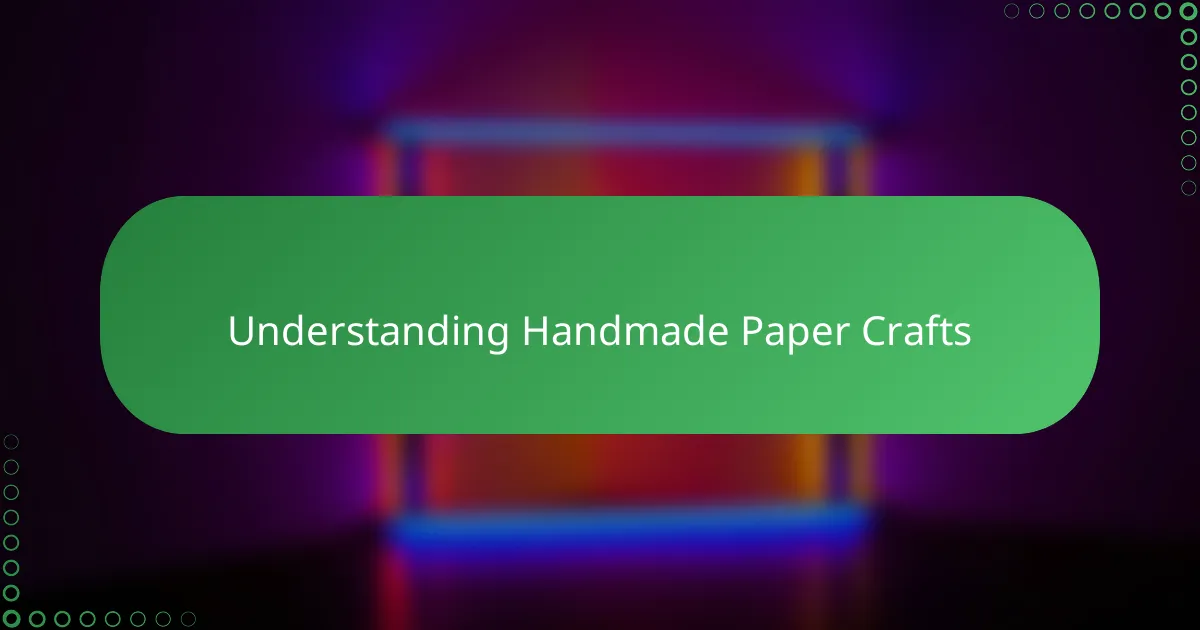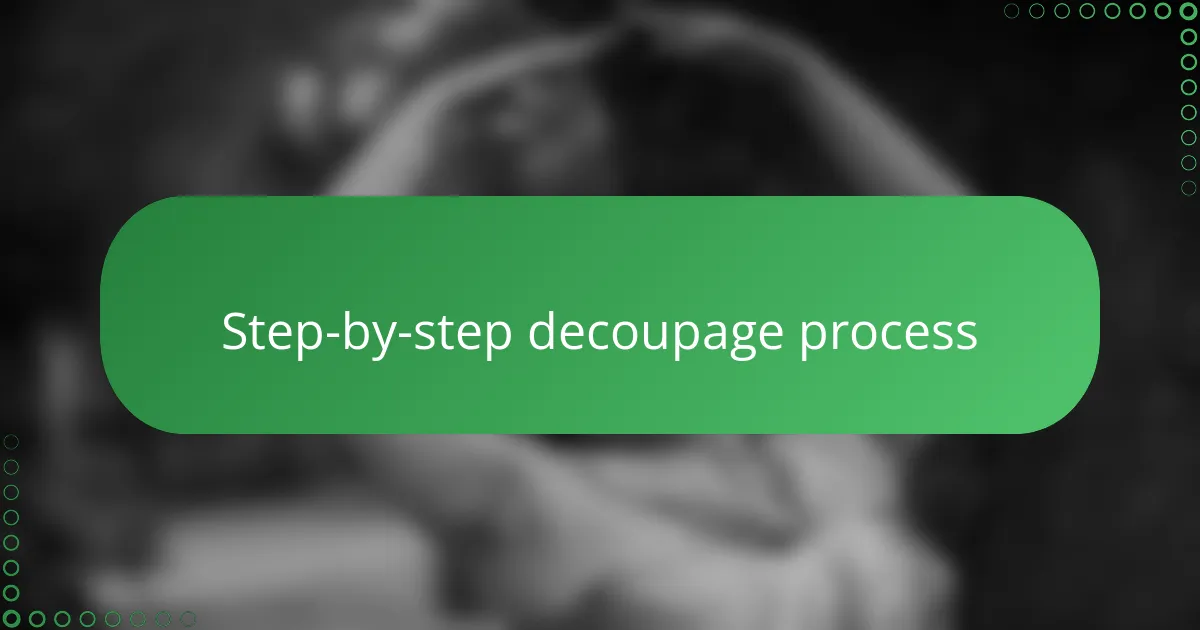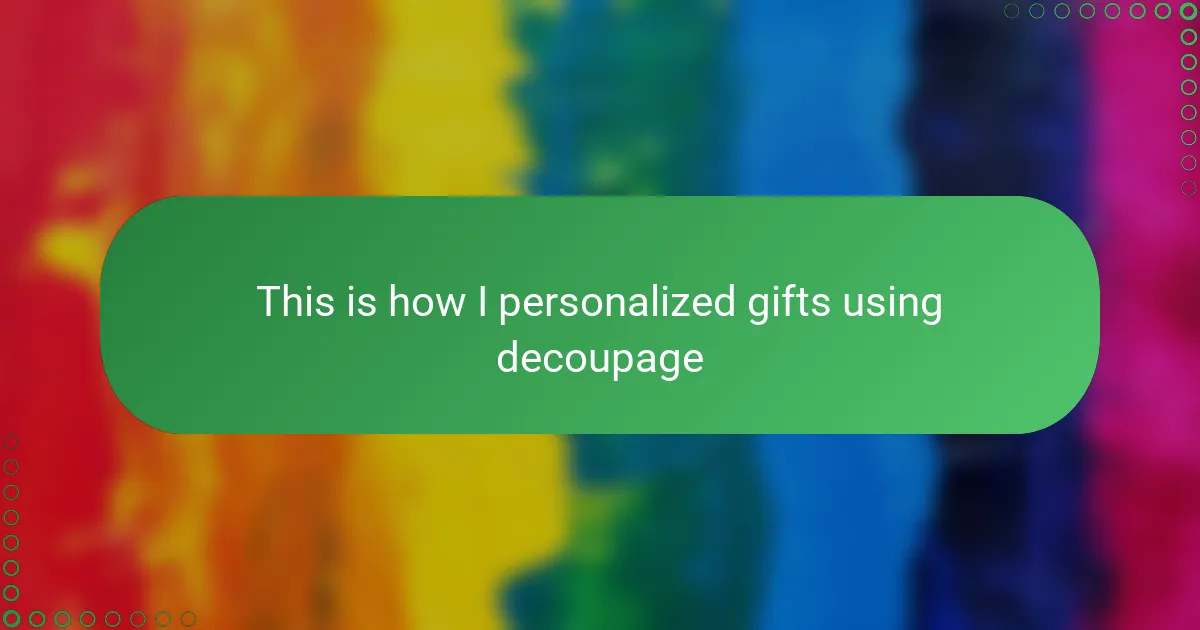Key takeaways
- Handmade paper crafts offer a unique tactile experience and personalization, emphasizing storytelling through its imperfections.
- Decoupage involves layering paper and requires patience, with careful selection of materials enhancing the final piece’s charm.
- Personalizing gifts with decoupage transforms ordinary objects into meaningful keepsakes that reflect the recipient’s personality.
- For longevity, use multiple thin coats of varnish, patience during drying, and archival-quality materials to protect your creations.

Understanding Handmade Paper Crafts
Handmade paper crafts have always fascinated me because they transform simple materials into something uniquely beautiful. There’s a certain magic in feeling the texture of handmade paper and knowing it was crafted with care and intention. Have you ever paused to think about how this tactile experience connects us more deeply to the art we create?
From my experience, handmade paper isn’t just a craft supply—it’s a story waiting to be told. Each sheet carries subtle imperfections, making every gift or project truly one-of-a-kind. Isn’t that what personalization is all about—embracing those small differences that make an item feel special?
Understanding handmade paper crafts also means appreciating the patience and skill involved in making the paper itself. The process demands attention to detail, much like decoupage, which reflects in the final piece’s charm and character. When you think about it, isn’t that the heart of all handmade artistry?

Basics of Decoupage Techniques
Decoupage, at its core, is all about layering paper cutouts onto a surface and sealing them with glue or varnish. When I first tried it, I was surprised by how straightforward the technique felt—almost like assembling a visual story piece by piece. Have you ever found joy in watching a flat image transform into a textured, lasting design right before your eyes?
One thing I learned early on is the importance of smoothing out each layer carefully to avoid wrinkles or bubbles. It’s a gentle, mindful process that requires patience, but it’s incredibly rewarding. In fact, those moments of focus helped me connect more deeply with the craft—don’t you find that slowing down like this makes the final gift even more meaningful?
Choosing the right paper is another key step. I often experiment with different textures and weights, especially preferring lighter handmade paper for its delicate charm. It’s fascinating how the paper’s thickness can change the entire feel of a piece, isn’t it? This subtle choice truly personalizes the outcome in ways that store-bought materials just can’t match.

Choosing Materials for Decoupage
Selecting the right materials for decoupage is like setting the foundation for a special story. I always start with handmade paper that has interesting textures or gentle color variations—it feels more alive to me. Have you noticed how the choice of paper can completely shift the mood of a project?
Choosing the adhesive and finish is just as crucial. I once used a matte varnish that gave a soft, vintage look, which perfectly complemented the delicate patterns I’d cut out. That subtle decision made the gift feel truly unique, as if it were wrapped in a quiet kind of magic.
Also, I consider the base surface carefully—wood, glass, or even tin. Each reacts differently with decoupage techniques, and experimenting with these variations has taught me so much about how materials influence the final piece’s durability and charm. Have you tried mixing unexpected materials for a personal touch? It’s a game-changer.

Step by Step Decoupage Process
Starting the decoupage process, I always begin by carefully preparing my base surface, whether it’s wood or glass. I make sure it’s clean and smooth because that sets the stage for everything to stick perfectly. Have you ever noticed how a little prep work can drastically change how well your paper adheres and how polished the final piece looks?
Next comes the moment I enjoy the most: selecting and arranging my paper cutouts. I take my time placing each piece, picturing how they’ll come together like parts of a puzzle. Sometimes I shift a design back and forth until it feels just right—doesn’t creative patience make the end result so much more rewarding?
Once the layout feels settled, I apply a thin layer of decoupage glue, smoothing the paper gently to avoid any bubbles. Sealing it all with a varnish is like giving the gift a protective hug, ensuring the design stays vibrant and lasting. I’ve found that these careful finishing touches are what truly transform a simple craft into a cherished keepsake.

Personalizing Gifts with Decoupage
Personalizing gifts with decoupage has, for me, always been about more than just decoration—it’s about creating something that speaks to the recipient’s personality. I remember customizing a plain wooden box with delicate floral patterns on handmade paper; seeing the recipient’s surprise made every careful brushstroke feel so worthwhile. Doesn’t that moment of giving something truly personal make the whole process feel even more special?
What I find fascinating is how decoupage invites us to layer stories and memories onto everyday objects. Each paper design isn’t just an image; it’s a statement or a sentiment carefully chosen to reflect someone’s tastes or shared experiences. Have you ever noticed how a small detail, like a favorite color or motif, can transform a gift into a treasured keepsake?
From my experience, the most meaningful personalized gifts come from embracing imperfections—those little wrinkles or uneven edges that handmade paper and decoupage naturally bring. They remind me that the gift wasn’t mass-produced but lovingly crafted with intention. Isn’t it those unique touches that make a present unforgettable?

Creative Ideas for Gift Designs
When I think about creative gift designs using decoupage, I often imagine layering unexpected patterns and textures that speak directly to the recipient’s style. For example, combining vintage botanical prints with bold geometric shapes on a simple journal can turn it into a conversation starter. Have you ever watched someone’s face light up when they recognize a favorite motif carefully incorporated into a gift?
Sometimes, I like to experiment with themed collages—like a travel-inspired box adorned with maps, stamps, and handwritten notes on delicate handmade paper. This approach not only personalizes the gift but also invites the recipient into a shared adventure or memory. Don’t you find that these little narrative details make the gift more heartfelt and memorable?
I’ve found that mixing materials—say, pairing soft handmade paper with a splash of metallic paint or fabric—can elevate a decoupage piece from pretty to truly eye-catching. These contrasts create depth and surprise, which I believe are essential for a gift that feels uniquely crafted. Have you tried blending media to express your creativity in gift design? It’s an exciting way to push boundaries and give something genuinely original.

Tips for Durable Decoupage Gifts
One thing I’ve learned to ensure my decoupage gifts last is to apply multiple thin coats of varnish rather than a single heavy layer. This not only protects the delicate handmade paper but also keeps the surface smooth and prevents cracking over time. Have you ever noticed how a well-sealed piece just seems to glow and hold its charm longer?
From my experience, patience during drying times is another key factor for durability. Rushing through the layers can trap moisture or cause sticky spots, which diminish the gift’s longevity. It’s a simple step that, in my opinion, reflects the care we put into each personalized creation.
Lastly, I always recommend using archival-quality glue and varnishes designed for paper crafts. They may cost a little more, but I’ve found that these materials resist yellowing and peeling much better than cheaper alternatives. Doesn’t it feel great knowing your thoughtful gift will be admired for years to come?
